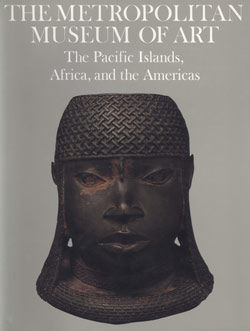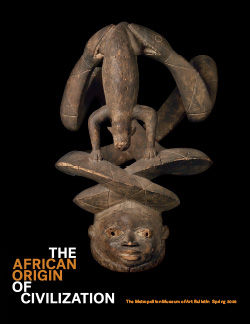Female Fertility Figure (Akuaba)
Disk-headed akuaba figures remain one of the most recognizable forms in African art. Akua ba are used in a variety of contexts; primarily, however, they are consecrated by priests and carried by women who hope to conceive a child. The flat, disklike head is a strongly exaggerated convention of the Akan ideal of beauty: a high, oval forehead, slightly flattened in actual practice by gentle modeling of an infant's soft cranial bones. The flattened shape of the sculpture also serves a practical purpose, since women carry the figures against their backs wrapped in their skirt, evoking the manner that infants are carried. The rings on the figure's neck are a standard convention for rolls of fat, a sign of beauty, health, and prosperity in Akan culture. The delicate mouth of the figure is small and set low on the face. The small scars just discernible below the eyes of this figure refer to a local medical practice as protection against convulsions. Most akua ba have abstracted horizontal arms and a cylindrical torso with simple indications of the breasts and navel; the torso ends in a base as opposed to human legs. The style of this sculpture is rare among other extant examples of akua ba due to its miniaturized naturalistic body, arms, and legs. Full-bodied figures such as this are believed to be a recent twentieth-century innovation within the akua ba sculptural tradition.
The name akua ba comes from the Akan legend of a woman named Akua who was barren, but like all Akan women, she desired most of all to bear children. She consulted a priest who instructed her to commission the carving of a small wooden child and to carry the surrogate child on her back as if it were real. Akua cared for the figure as she would a living baby, even giving it gifts of beads and other trinkets. She was laughed at and teased by fellow villagers, who began to call the wooden figure Akua ba, or "Akua's child." Eventually though, Akua conceived a child and gave birth to a beautiful baby girl. Soon thereafter, even her detractors began adopting the same practice to overcome barrenness.
All genuine akua ba are female images, primarily because Akua's first child was a girl but also because Akan society is matrilineal, so women prefer female children who will perpetuate the family line. Girls will also assist in all household chores, including the care of any smaller children in the family.
After influencing pregnancy, akua ba are often returned to shrines as offerings to the spirits who responded to the appeals for a child. A collection of figures becomes an advertisement for the spirits' ability to help women conceive. Families also keep akua ba as memorials to a child or children. The figures become family heirlooms and are appreciated not for their spiritual associations, but rather because they are beautiful images that call to mind a loved one.
Due to rights restrictions, this image cannot be enlarged, viewed at full screen, or downloaded.
This artwork is meant to be viewed from right to left. Scroll left to view more.





